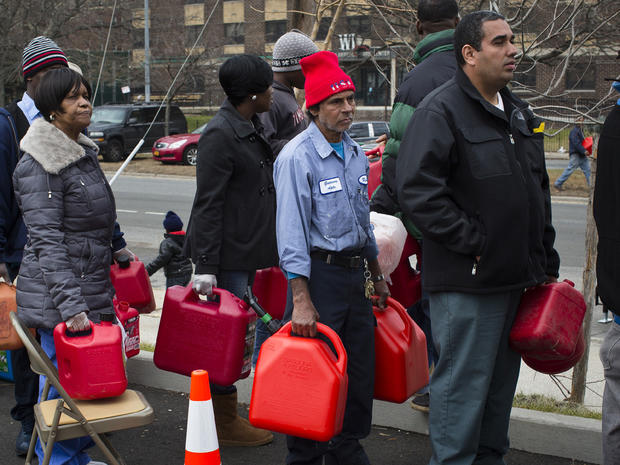Delays in restoring power after Sandy anger many
NEW YORK Utility companies in New York and New Jersey closed in on restoring power Sunday to the last of the 8.5 million who lost it during the superstorm two weeks ago and a subsequent nor'easter, but tens of thousands of homes and businesses were too damaged to receive electricity, and delays and a dearth of updates have angered residents and government officials alike.
Power problems remained unresolved on New York's Long Island, where about 300 people protested Saturday at an office of the beleaguered Long Island Power Authority. About 130,000 of its customers still didn't have power Sunday, LIPA said, not including the homes and businesses that were too damaged.
"Each day you get a different answer from them," Carrie Baram, 56, said of LIPA. Monday will mark two weeks since she's had power at her home in Baldwin Harbor on Long Island.
She and her husband have gone to her parents' home a few times to shower, and sent their adult children to stay with friends. They had to throw out most of the food in their refrigerator, so they've been eating meals out, which is getting expensive.
"It's dark, it's frightening, and it's freezing," she said.
Workers were repairing unprecedented storm damage as fast as they can, LIPA said. About 6,400 linemen and 3,700 tree trimmers were at work, compared with 200 linemen on a normal day, said Chief Operating Officer Michael Hervey. He blamed the spotty information updates partly on outdated technology it's in the process of updating.
"I certainly feel the frustration of customers whose power remains out. Our hearts go out to them," said Hervey.
Phillip Jones of Uniondale described feeling powerless, reduced to hoping each day would be the day the power came back on. Saturday was that day.
"You get a busy signal, busy signal, busy signal" when calling LIPA, he said.
Jones, a parole officer, had to miss two weeks of work. He and his wife and two children had been sleeping in one bed to try to stay warm.
- Sick, frail struggle most in storm's aftermath
- Volunteers help the Rockaways after Sandy
- Frustrated residents protest outside NY utility
- Sandy: Tempers heated among New Yorkers still in the cold
Most of the rest of the power outages were in New Jersey, where residents received a boost from kindred spirits in Louisiana, whose memories of devastating Hurricane Katrina prompted them to send tons of relief items north via rail in a train that arrived Saturday, organizer Donna O'Daniels said.
The donations came alongside relief workers, volunteers and demolition crews who have flocked to the region in recent days to assist with the massive cleanup. For many, the prospect of repairing or rebuilding damaged homes looms as a long-term challenge.
Thousands of displaced New Jersey residents are calling real estate offices, looking to rent a home or apartment while they figure out what to do about their storm-ravaged homes. Others are joining waiting lists at hotels filled with evacuees and out-of-state utility workers.
"A lot of people who don't have a home to go back to, a lot of property destroyed," Sen. Bob Menendez of New Jersey said Sunday on CNN's "State of the Union." "So housing is a big issue as we move forward here, to have a place for people to call home for those who don't have other resources or family members to stay with in the interim."
The superstorm also claimed another New York City life, police said. Albert McSwain, 77, died Saturday from injuries he suffered when he fell in his darkened apartment building Oct. 31. He had a head injury and had been paralyzed. McSwain was the 43rd person in the city whose death was related to the storm.
- Volunteers head for flood-damaged N.Y. areas
- Jersey Shore residents return to damaged homes
- N.J. moves Sandy evacuees from tent shelters
- FEMA camps house struggling Sandy survivors in N.J.
Fuel remained another major question two weeks after the storm. No one knows exactly what will happen in the coming week as commuters and businesses look for gas to get back to work.
Lines at gas stations in New York City remained long over the weekend after rationing was put in place for the first time since the 1970s Arab oil embargo, but were only a shade of the nightmare they had been in recent days.
In New Jersey, state-imposed gas limits continued in 12 of 21 counties. The rationing based on license plate numbers will be evaluated to see how much longer it's needed, according to a spokesman for Gov. Chris Christie.
Though New York and New Jersey bore the brunt of the destruction, at its peak, the storm reached 1,000 miles across, killed more than 100 people in 10 states, knocked out power to 8.5 million and canceled nearly 20,000 flights. More than 12 inches of rain fell in Easton, Md., and 34 inches of snow fell in Gatlinburg, Tenn. Damage has been estimated $50 billion, making Sandy the second most expensive storm in U.S. history, behind Katrina.
